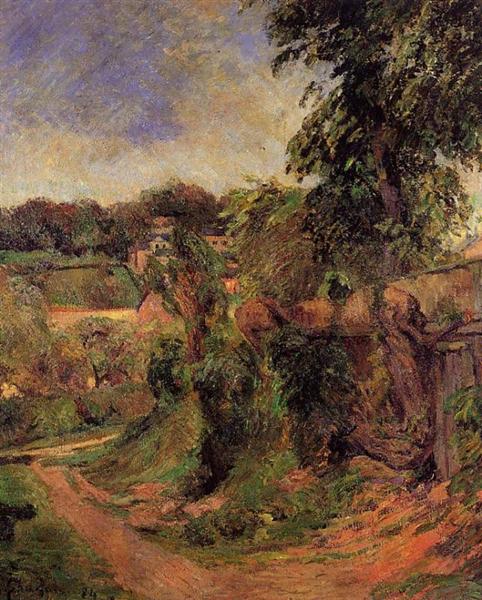Description
Paul Gauguin, central figure of post -impressionism, addresses in his work "Near Ruan" (1884) a time when he sought to renew the vision of the landscape, distancing himself from his contemporaries through an exuberant palette and an emotional approach. This painting reflects its interest in French rurality, an issue that becomes recurring in its initial stage, before its famous trip to Tahiti and its subsequent evolution towards a more symbolic and expressive style.
The work presents a Praderile landscape, with fields of a vibrant green that extend towards an open space, where you can distinguish a village in the distance, next to an air of calm. The composition is structured in a way that guides the viewer's gaze along the canvas; The horizontal lines of the countryside and the sky invite a relaxed and deep contemplation. This use of horizontality is characteristic in the works of Gauguin, who, despite being immersed in the world of impressionism, begins to experiment with simplification and synthesis in representation.
One of the most striking aspects of "near Ruan" is the vibrant color palette. The shades of green and yellow are complemented with celestial and cloudy nuances, evoking an almost dreamlike atmosphere that invites reflection. The lack of fine details in houses and trees also indicates a more schematic approach, pointing out their interest in the essence of the landscape rather than its faithful reproduction. This way of representing reality in painting is a distinctive feature of Gauguin, who sought to communicate an emotion or a sensation through his works, instead of simply capturing a moment from life.
As for the presence of the human figure, the painting It lacks obvious characters, which creates a feeling of loneliness and introspection. This approach not only differs from the agitation of previous works of other impressionists, where the human figure is usually central, but reflects Gauguin's desire to concentrate on the essence of the landscape in its purest form. In this way, the viewer becomes the only observer of this idyllic environment, invited to immerse himself in the serenity that emanates from the landscape portrayed.
This work can also be contextualized within Gauguin's trajectory, which after "near Ruan" would enter an artistic path less focused on naturalistic representation and more on symbolism. The use of bolder colors and shapes in subsequent works, such as "The Scream" and "The vision of the island of the afternoon", is a notable evolution of the proposal that already begins to take place here.
In conclusion, "near Ruan" is a representation that, beyond being a rural landscape, establishes the basis for emotional and symbolic exploration that will characterize Gauguin's work in later years. With its unique palette, its spinning composition of formal elements and the deliberate absence of figures, Gauguin manages to create a contemplation space that resonates in the viewer, turning a simple landscape into a reflection on the very essence of human experience. This work is a will of the beginning of its artistic journey to the exotic and the spiritual, a path that art history would recognize and celebrate in the following decades.
KUADROS ©, a famous paint on your wall.
Hand-made oil painting reproductions, with the quality of professional artists and the distinctive seal of KUADROS ©.
Reproduction service paintings With a guarantee of satisfaction. If you are not completely satisfied with the replica of your painting, we refund your money 100%.

